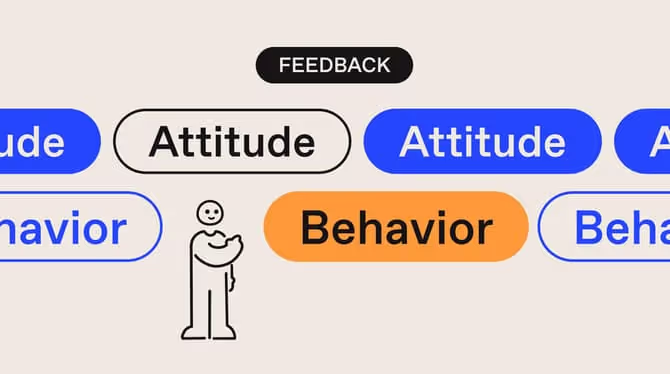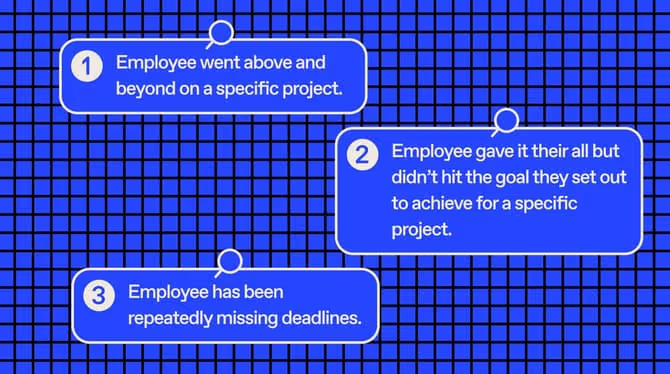How to give feedback: 5 best practices for managers

Discover Workleap Officevibe's benchmark report on 12 key employee engagement metrics

Managers know that giving clear, consistent feedback is key to improving employee engagement, and helping them to continuously develop and improve. Learning how to give meaningful and constructive feedback is one of the most important tasks of being a manager.
Whether you're giving positive feedback that helps your employees know they’re doing well, or delivering more constructive and negative feedback that helps them spot things they might have missed, doing so effectively makes all the difference. Despite how much we know about the importance of giving employee feedback...
If you’re not focused on giving frequent and clear employee feedback, you might be missing out on the chance to develop and challenge your team. Learn how to give feedback that resonates with the framework outlined below.
SBI model: a framework for better feedback
Imagine in your next one-on-one meeting, you tell your employee: “You're doing great with your customer calls, but your reports need some improvement.”
You may think you’ve just had a high quality conversation with your employee. But your employee might leave the conversation thinking: “What about my customer calls is going well, and what about my reports needs improvement?”
This is where the Situation-Behavior-Impact (SBI) model can help you give clear, actionable feedback.
The SBI framework:
- Give context to the situation
- Identify the behavior to be discussed, and
- Share the impact this behavior had
In the feedback example above, you could reframe both the positive and negative feedback using the S-B-I model like this:
{emphasize}
How to give positive feedback
In the client call I shadowed you on this morning (situation) you did an excellent job describing the features and benefits of our products (behavior). As a result, the client was able to make their purchase with confidence (impact).
{emphasize}
{emphasize}
How to give negative feedback:
When you completed your inventory report on Friday (situation) you forget to include important details on certain products (behavior).This created inventory discrepancies for our team which lead to extra work being done (impact).
{emphasize}
In both the above scenarios, your employee will know exactly what you're referring to and why it's important. To take constructive feedback one step further, you can then focus on a request for improvement.
For example: “Next Friday, please re-read your report or have your colleague check it over before you submit.”
Remember that feedback shouldn’t be arbitrary. For it to be useful and impactful, it has to be focused on what a person did (as opposed to who they are as a person) and on the outcome of their actions. Employee feedback must be applicable in the future for it to be worth sharing. The goal of feedback should always be to help the other person improve.
{emphasize}
💡See our comprehensive list of employee feedback examples for more ideas.
{emphasize}
Feedback sessions: before, during, and after
Do you have a feedback session or a performance review coming up? Setting up a trusting and open environment to give a person effective feedback can be just as important as the content of what you say when it comes to delivering feedback that lands.
Before: check in with your employees
Make sure your employees are in a good headspace to hear feedback. Don’t have these delicate conversations on the fly or when either of you are distracted. You could use your weekly 1-on-1 meeting to ensure that your employee is coming into the conversation with the right mindset. You should also check in with yourself, and make sure your headspace is cleared too. Consider doing a short mindfulness meditation before entering the conversation.
During: give them your full attention
During the conversation, make sure to give your employee your complete attention so they know that you’re invested in the dialogue. When you're giving feedback, use open body language, like having your arms to the side rather than crossed and making direct eye contact, to make sure they feel comfortable and safe.
{emphasize}
Don't forget: mute your email notifications and turn your phone on silent!
{emphasize}
After: check for clarity
Once the conversation ends, thank your employee for taking the time to hear you out. Ask them if they understand exactly what it is you’ve said, and if your suggestions for the future behaviors are clear.
{emphasize}
You can try saying: “Do you feel you have everything you need to get started on the next steps? If not, what’s missing?”
{emphasize}
Ask them how they feel about the feedback and to share their perspective on your impressions. Feedback from one person to another is just that, an impression, so let employees share their perspective on the matter too.
5 Best practices for giving feedback that lands
Beyond what we’ve already covered, here are some quick tips to help you successfully handle feedback conversations.
1. Don’t wait until it hurts
Make sure you’re giving feedback often, and don’t wait until a situation implodes to share feedback. If you consistently make feedback (both positive and negative) part of the general conversations you’re having with employees, it won’t feel like a big deal when you have something specific to share.
2. Avoid any criticism
When giving feedback, imagine that you’re sharing an observation from a movie clip that you watched. You’re thinking back to the scene which you witnessed, and you’re simply sharing the observation of what you saw. This means, no statements or judgement about your employees character or personality. Focus on behavior and performance.
3. Be open-minded
The feedback you give is your perspective, and it's important to remember that it's not the only one. Your employee might see things differently, just as someone outside of the situation may see things differently, too. Always be open to your feedback turning into a discussion that may lead to a conclusion you hadn't considered.
4. Ask for feedback, too
Find out how your employees are feeling about the feedback you’re currently giving them by asking for their feedback. Officevibe's employee feedback tool lets team members share their thoughts with you anytime, with an option for anonymity. Send your response in-app, turning feedback into a two-way chat — while employees stay anonymous (or not).
5. Shift your practice for virtual
As we continue to work virtually, remember the nuances involved with virtual communication. If you have something important to say, consider the tone that comes across over Slack. Your message may be perceived in the wrong way if you don’t take the time to connect face to face. Make sure that important pieces of feedback are delivered over video chat and that you’re still maintaining your presence, even when remote.
If you want to keep your employees engaged, give them effective feedback that resonates!
Give HR and managers the clarity, confidence, and connection to lead better every day.


%20(1).avif)


.avif)
.avif)






.avif)

